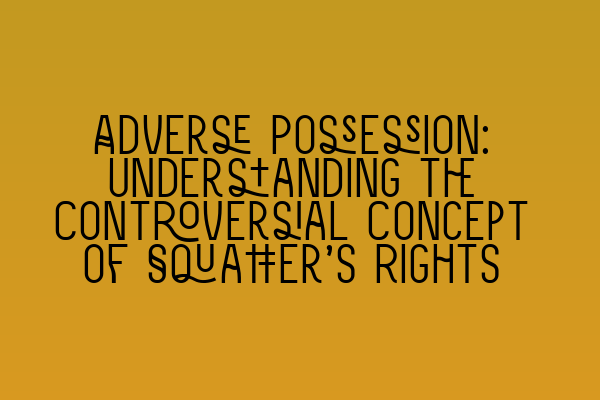Adverse Possession: Understanding the Controversial Concept of Squatter’s Rights
When it comes to property law, there are numerous fascinating and sometimes controversial concepts that come into play. One such concept is adverse possession, which revolves around the idea of squatter’s rights. Adverse possession refers to the legal principle that allows a person to acquire ownership of someone else’s property by occupying it openly, continuously, and without permission for a specified period of time.
Although adverse possession may seem like a straightforward concept, it is essential to delve deeper into its intricacies and understand its implications. In this blog post, we will explore the concept of adverse possession, its history, the elements required to establish a claim, the legal controversies surrounding it, and its application in various jurisdictions.
A Brief History of Adverse Possession
The origins of adverse possession can be traced back to ancient Roman law. The idea behind adverse possession was that an owner who neglected their property, and allowed others to use it openly and exclusively for an extended period, should not be entitled to retain ownership. This principle aimed to encourage the productive use of property and discourage negligence.
Over the centuries, adverse possession evolved and became codified into modern property laws. Different jurisdictions have set different time periods required for adverse possession claims, typically ranging from 5 to 30 years. Additionally, various legal systems have established specific requirements and criteria that must be met to successfully establish a claim.
The Elements of Adverse Possession
To successfully establish an adverse possession claim, certain elements need to be satisfied:
- Actual Possession: The claimant must demonstrate actual possession of the property. Mere intention or casual use is insufficient. They must physically occupy and control the property.
- Open and Notorious Possession: The possession must be visible and obvious to the true owner. The claimant can’t conceal their occupation.
- Exclusive Possession: The claimant must possess the property without sharing it with others, including the true owner.
- Continuous Possession: The possession must be continuous and uninterrupted throughout the prescribed statutory period.
- Hostile Possession: This element does not necessarily require hostility in the traditional sense of animosity; instead, it means holding the property without the true owner’s permission.
- Statutory Period: Finally, the occupation must persist for the statutorily prescribed period, which varies depending on the jurisdiction.
The Controversy Surrounding Adverse Possession
Adverse possession has garnered its fair share of controversy over the years. Some argue that it promotes fairness and discourages landowners from sitting on neglected or abandoned properties. It incentivizes the productive use of land and prevents the waste of resources.
On the other hand, critics argue that adverse possession can lead to unjust outcomes, as it allows someone to take possession of another person’s property without their consent or compensation. This can be particularly problematic when it comes to cultural or historical properties that hold significance beyond mere monetary value.
In highly developed areas, adverse possession can give rise to disputes and conflicts between property owners and individuals claiming squatter’s rights. These conflicts often necessitate legal intervention and can result in costly and lengthy litigation processes.
Adverse Possession in Various Jurisdictions
Each jurisdiction has its unique laws regarding adverse possession. For example, in England and Wales, the law recognizes a range of time periods depending on the nature of the claim. The minimum duration is 10 years for registered land and 12 years for unregistered land. However, this can be reduced in certain circumstances. Scotland follows a different approach, with the statutory period for adverse possession set at 10 years.
Understanding the specific laws and requirements in your jurisdiction is vital to determine the viability of an adverse possession claim and navigate the legal complexities associated with it.
Conclusion
While adverse possession remains a controversial concept, it is a fascinating topic within property law. Understanding its history, the elements required to establish a claim, and the controversies surrounding it is crucial for property owners, professionals in the legal field, and anyone interested in the intricacies of property rights.
If you want to explore more legal concepts related to property law or other areas of law, check out these related articles:
- SQE Contract Law: Analyzing Landmark Cases and Influential Judicial Decisions
- Understanding Contractual Capacity: Rights and Limitations
- Interactive SQE Mock Tests for Contract Law: Test Your Knowledge
- Join Our SQE Contract Law Webinars: Expert Insights and Guidance
- SQE Prep: Mastering the Essentials of Contract Law
Don’t hesitate to reach out to SQE Property Law & Land Law for expert legal advice and guidance. Our team of experienced solicitors can assist you with various property-related matters, including adverse possession claims and other property law issues.
